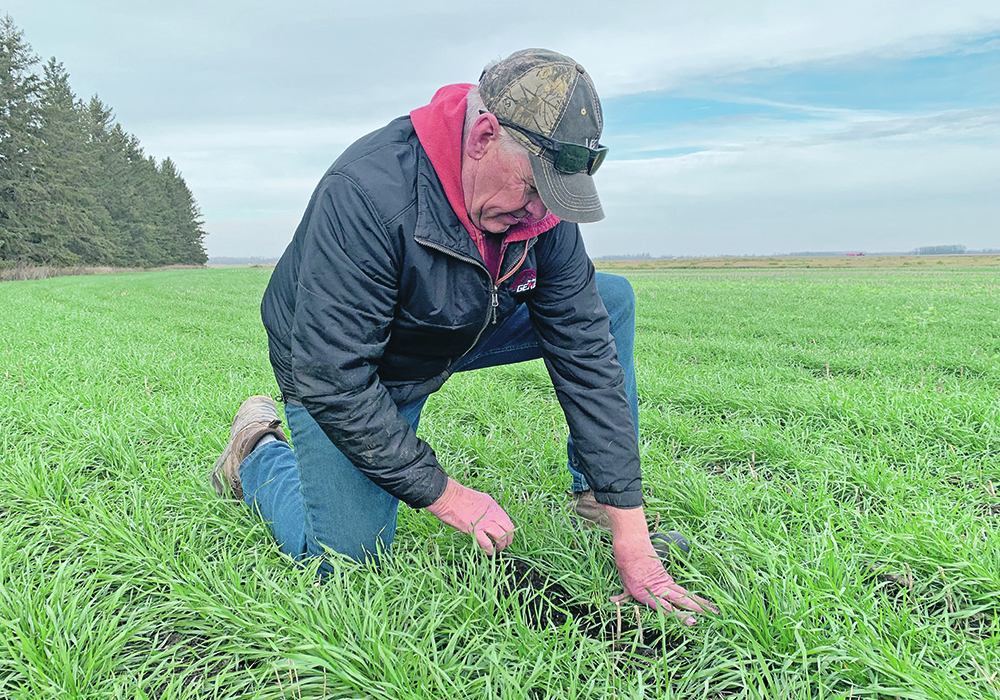Warm spells followed by refreezing are usually hard on the crop, but a heavy blanket of snow keeps it safe this year
For a nice change, March hasn’t yet turned out to be a scary time for Manitoba winter wheat growers.
The crop seems to be lying safely.
“Snow is the biggest factor. Even though we got cold, there’s a lot of snow,” said East Selkirk farmer Doug Martin, whose winter wheat crop entered dormancy lush and in good condition.
That seems to be a general situation among Manitoba’s winter wheat growers. Much of the crop got seeded in late August and the first week of September, allowing it to get well established before the descent of winter in November.
Read Also

Government, industry seek canola tariff resolution
Governments and industry continue to discuss how best to deal with Chinese tariffs on Canadian agricultural products, particularly canola.
That seeding was an act of hope and faith for most farmers because much of Manitoba was still bone-dry and soil moisture was almost non-existent in some areas when crops were seeded, but enough rainfall hit during autumn to get crops growing and ready for dormancy.
Ducks Unlimited Canada winter wheat agronomist Alex Griffiths has been following the condition of the crop. There are still a few weeks of winter to go, but he’s feeling confident that crops could make it through.
“I think we’re probably, knock on wood, going into a really good spring with very minimal winterkill,” said Griffiths.
Late February tends to see warm spells causing snow to melt, which then refreezes at -20 C temperatures, killing the exposed winter wheat plants. Over the course of a winter, the plants lose some of their hardiness, so much winterkill occurs in late winter, when spring is just around the corner.
However, this year’s crops are protected with lots of snow, none of the major growing areas have soil temperatures hitting the -20 mark, and many crops went into winter in great condition.
“Most of the plants I saw were huge and in good shape,” said Griffiths, who spends much of his time in fall and spring visiting winter wheat fields.
Winter wheat has lost a lot of popularity in Manitoba in recent years. Later harvests of spring crops have made timing difficult, heavy rains have fallen in late summer and early fall preventing seeding during the traditional winter wheat seeding period, winterkill in low-snow years has hurt yield and forced reseeding, and spring wheat has done very well.
However, there are signs it’s hanging on with long time growers and regaining some favour.
This year Manitoba has about 70,000 acres seeded with winter wheat, which is more than double what was seeded two years ago, Griffiths said.
Some of that probably comes from the impact of the drought, which gave winter wheat the opportunity to show its advantage in exploiting snowmelt and spring rains better than spring cereals.
Griffiths said winter wheat usually has a 10 to 20 percent yield advantage to spring wheat, but last year he saw some farmers getting about 50 percent more than their spring cereals.
“When you have a dry year, you see the spread between winter wheat and spring wheat widen,” said Griffiths.
DUC promotes winter wheat because it provides spring green cover for bird nests. Farmers who do well with winter wheat like being able to spread out their field operations and avoid some spring seeding work.
The crop plays an important role for farmers looking for ground cover after harvesting low-residue crops like canola.
A complication for winter wheat in recent years has been the late harvests many canola crops have experienced. With the canola coming off later than the first week of September, the traditionally ideal time for winter wheat often passes by.
Dedicated growers like Martin hope this is a year that once again shows the value of winter wheat.
“Soil temperatures aren’t too cold. We have lots of insulation. We’ve had a good winter for winter wheat,” said Martin.


















